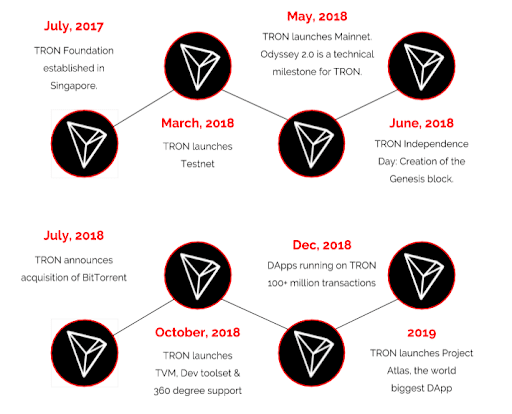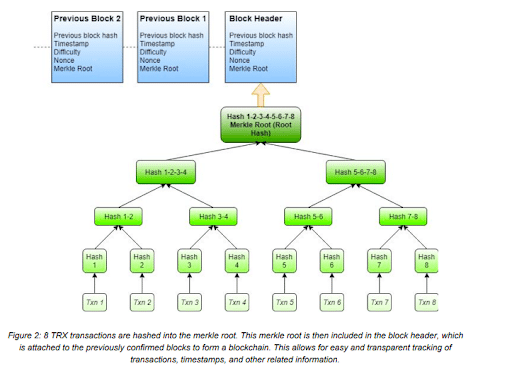What is Tron (TRX)?

Advertisements
Tron combines blockchain technology, focusing on entertainment, content creation, and various other sectors. It operates as a distributed ledger, recording transactions and activities in a secure and tamper-resistant manner. The ultimate goal of this platform is to create a more open, transparent, accessible, and decentralized internet where creators and consumers can engage directly without the constraints of intermediaries.
The History of Tron (TRX)
Tron (TRX) has an interesting history, with a journey that began in 2017 bolstered by the vision of revolutionizing the digital content and entertainment industries through blockchain technology. Tron’s story encompasses several key milestones, from its inception to its growth as a prominent blockchain platform.
In July 2017, Tron was founded by Justin Sun, a young entrepreneur with a background in technology and blockchain. In December, Tron launched its open-source protocol, making its underlying technology accessible to developers and enthusiasts. This marked the beginning of its technical development and its commitment to openness and collaboration.
In the months from March to May 2018, Tron achieved significant technical milestones. By March 2018, they introduced the protocol’s Testnet, Blockchain Explorer, and Web Wallet, providing users and developers with tools to interact with the Tron ecosystem.
In May 2018, Tron Mainnet was launched, known as the Odyssey 2.0 release. This marked the transition from a project in development to a fully operational blockchain platform.
In June 2018, Tron declared its independence by creating the Genesis block, signifying the establishment of its own blockchain separate from its initial Ethereum-based token. In July 2018, Tron made headlines by acquiring BitTorrent, a leading peer-to-peer file-sharing protocol, which was seen as a strategic move to integrate a massive user base into the Tron ecosystem.
October 2018 saw the launch of the TRON Virtual Machine (TVM), an essential toolset for developers to build and deploy decentralized applications (DApps) on the Tron network. Tron’s roadmap expanded to include Project Atlas, an initiative aimed at integrating BitTorrent’s users and technology into the Tron ecosystem, further strengthening its decentralized content distribution model.
Beyond the initial milestones, Tron continued to grow its ecosystem. It forged partnerships, attracted developers, and ventured into the realm of decentralized finance (DeFi). Tron’s vibrant community and engaged stakeholders contributed to its ongoing development and adoption in various industries. Tron (TRX) roadmap | Source: Tron
Tron (TRX) roadmap | Source: Tron
How Does Tron (TRX) Work?
Tron functions within a blockchain framework, characterized by a decentralized and secure digital ledger.
This ledger records all transactions and activities on the platform in a chronological and immutable manner. The platform employs smart contracts, which are self-executing digital agreements.
These contracts are programmed to automatically execute when specific conditions are met. Smart contracts on Tron enable a wide range of functions, from facilitating transactions to executing complex business logic, all without requiring intermediaries.
On the Tron platform, developers have the ability to create decentralized applications (DApps). These applications function on the blockchain, offering users heightened security, transparency, and self governance. A wide array of use cases can be covered by DApps, from gaming and entertainment to finance and social networking.
Additionally, Tron uses a consensus mechanism known as Delegated Proof of Stake (DPoS). In DPoS, token holders can vote for representatives (super nodes) who validate transactions and secure the network. This approach enhances transaction speed and scalability while reducing the energy consumption associated with traditional Proof of Work (PoW) systems. The Proof of Work (PoW) consensus mechanism (Source: Tron)
The Proof of Work (PoW) consensus mechanism (Source: Tron)
A core focus of Tron is disrupting the traditional content distribution model. Content creators can directly share their work with consumers without the need for intermediaries such as media companies or streaming platforms. This empowers creators to have greater control over their content and revenue.
TRX functions as the inherent cryptocurrency of the Tron platform. It serves as a medium of exchange within the ecosystem and eases transactions on the blockchain. Additionally, TRX is used to incentivize users for participating in activities like staking, voting, and contributing to the network.
The blockchain platform aims to enhance blockchain interoperability by collaborating with other blockchain networks. This approach allows for seamless communication and asset transfer between different blockchains, promoting a more interconnected and versatile blockchain ecosystem.
Tron is also making strides in the decentralized finance (DeFi) sector. Through the creation of DeFi protocols and applications, users can access financial services such as lending, borrowing, and trading in a decentralized and permissionless manner.
The platform gives considerable importance to its community. Participants, including users, developers, and stakeholders actively participate in shaping the direction of the crypto project through governance mechanisms, proposals, and discussions. This collaborative approach fosters innovation and ensures that the platform evolves according to the needs and aspirations of its users.
In essence, Tron operates as an ecosystem where decentralized technology meets entertainment, content creation, and various other industries. Through its innovative approach to blockchain, smart contracts, and community involvement, Tron seeks to create a more equitable and efficient digital landscape.
Pros and Cons of Tron (TRX)
- Pros
Cons
Tron is built with a strong focus on scalability, allowing it to handle a capacity of up to 2,000 transactions per second. This transaction speed exceeds that of other blockchain platforms, like Ethereum.
- Tron has very low transaction fees, making it more affordable for users. Its network boasts of $0.000005 as the average transaction fee.
- Tron supports smart contracts, which are automated and capable of self-execution, streamlining transactions and agreements.
- The decentralized content distribution network will allow users to share and access content without having to go through middlemen.
- Tron is focused on the entertainment and gaming industries.
- Tron is relatively a new platform. This implies that there could exist certain errors or security weaknesses that haven’t been resolved at this point.
- Tron has been involved in some controversies, such as allegations of plagiarism and misleading investors.
- Tron is developed and controlled by a single entity, the Tron Foundation. This, to some people, could mean the platform is less decentralized and more vulnerable to censorship.
- Some of the features of Tron, such as the decentralized content distribution network, are still under development. This means that they may not be fully functional or reliable.
- There are a number of other blockchain platforms that are also focused on the entertainment and gaming industries competing with Tron.
The Bottom Line
The future holds exciting possibilities for Tron (TRX) as the blockchain platform continues to evolve and expand its impact on various industries. With a focus on decentralization, innovation, and user empowerment, the platform is poised to make significant contributions to the blockchain and digital content landscape.
Tron’s vision includes merging BitTorrent’s extensive user base of over 100 million users with its blockchain network through Project Atlas. This integration aims to create a more efficient and decentralized content-sharing ecosystem, providing creators and consumers with enhanced control and incentives for participating in the network.
Tron could also continue to expand its DeFi offerings, providing users with decentralized crypto lending, borrowing, trading, and other financial services. The future might also see the launch of even more innovative and interactive DApps that leverage the platform’s capabilities.
Tron’s commitment to interoperability could lead to collaborations with other blockchain platforms, enabling seamless communication and asset transfer between different networks. This could further expand the use cases and utility of its ecosystem. Moreover, as blockchain technology evolves, Tron could focus on further improving its scalability and transaction processing speed. These enhancements would make the platform more capable of handling a higher volume of transactions and interactions.
Moreover, the platform’s active and highly engaged community is likely to play a significant role in shaping its future. Governance mechanisms could evolve to give the community more say in decision-making and the direction of the platform’s development. Tron’s versatile nature makes it suitable for applications beyond content distribution and entertainment. It could find applications in supply chain management, identity verification, healthcare, and more, as its technology proves adaptable to various use cases.
The platform’s commitment to staying at the forefront of blockchain technology could lead to the development of novel features, improvements in consensus mechanisms, and security enhancements to ensure the platform’s long-term sustainability.
Advertisements
































